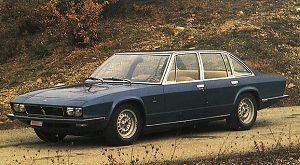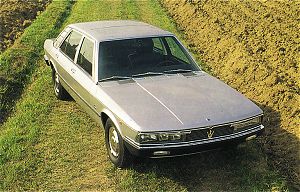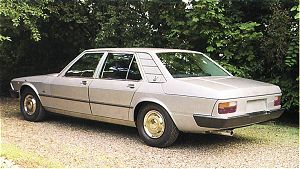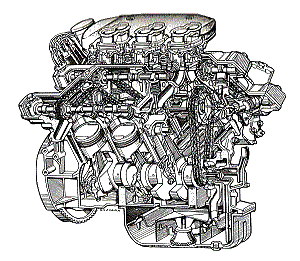
"A brief return with French flavouring!" |
 |
||
|
|
|||
|
Before continuing with the evolution of the Quattroporte, we must record an idea proposed by the Casa to produce, in limited numbers, a car with coachwork by Pietro Frua made especially for a very important client, Karim Aga Khan, already the owner of other Maseratis. |
|||
|
However this 'Quattroporte' never reached the production stage and remained a prototype, due largely to the political situation at Citroën, the then owners of Maserati, who encouraged a policy of producing cars utilising as many French components as possible. |
|||
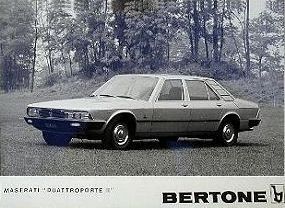 |
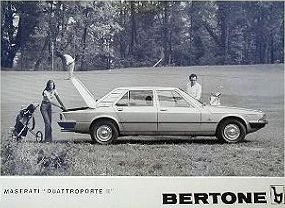 |
|
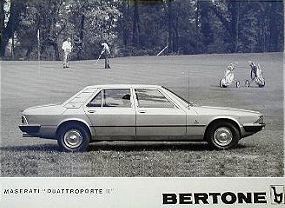 |
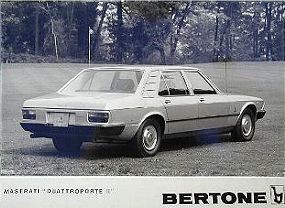 |
|
|
As the years passed by, production of the Quattroporte I ended and the need for a new four-door saloon became apparent. |
|||
The prototype of this model, designated AM 123 by the factory, was first displayed at the Paris Motor Show on the 3rd October 1974. |
|||
Thanks to the use of the front-wheel drive, the Quattroporte II had a spacious interior, with a clear floor-pan free from the traditional transmission tunnel, and an extremely spacious boot compartment (25 cu ft). |
|||
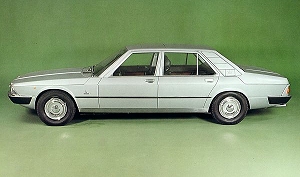 |
The drive was effortless in spite of it's size: steering was particularly light with a total lack of adverse reactions. The level of ride comfort was extremely good thanks to the use of Citroën's hydropneumatic suspension, power steering and the servo-assisted brakes. However the car lacked something in the power and torque department, enough to make one weep for the power of that V8 engine. Performance figures from the official factory brochure claimed a top speed in excess of 200 kph (125 mph) and acceleration from 0 to 100 kph (62 mph) in nine seconds. |
||
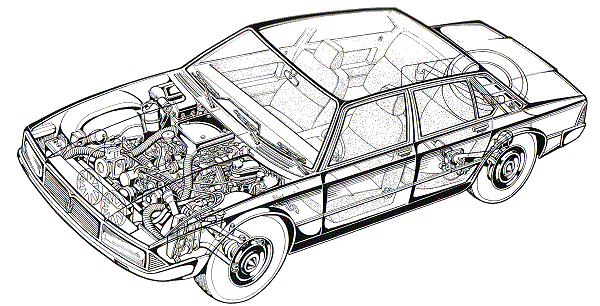 | |
| X-ray view of the Quattroporte II | |
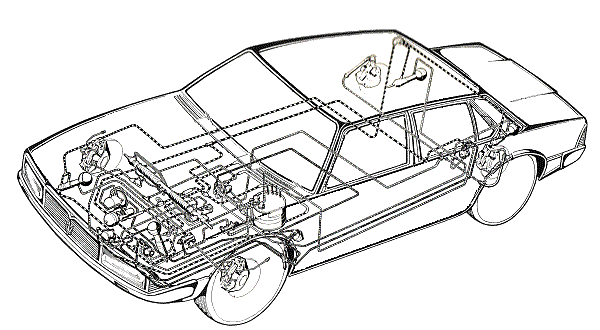 | |
| The hydraulic system of the Quattroporte II | |
| 1 | Hand brake (released) | 9 | Electric sun roof |
| 2 | Interior light | 10 | Driver's electric window (left) |
| 3 | Heated rear window | 11 | Rear passenger electric window (left) |
| 4 | Headlight door | 12 | Electronic clock |
| 5 | Fog light | 13 | Front passenger electric window (right) |
| 6 | Hazard warning light | 14 | Rear passenger electric window (right) |
| 7 | Instrument panel illumination | 15 | Glove box |
| 8 | Headlights | 16 | Passenger side air vent |
 |
| 17 | Air vent grill control | 26 | Ignition switch |
| 18 | Central air vent | 27 | Clutch pedal |
| 19 | Air blower switch | 28 | Padded steering wheel |
| 20 | Air-conditioning temperature switch | 29 | Driver's foot rest |
| 21 | Air-conditioning control lever | 30 | Hand brake pedal |
| 22 | Manual choke | 31 | Levers for opening boot and fuel cap |
| 23 | Gear lever | 32 | Lever for opening engine bonnet |
| 24 | Accelerator pedal | 33 | Direction indicator lever | 25 | Brake pedal | 34 | Windscreen washer and wiper lever |
Standard equipment included air conditioning, tinted windows, sun blinds on all windows, radio cassette, electric windows, power steering and a heated rear window. Optional extras included leather interior and an electric sliding roof. |
|||
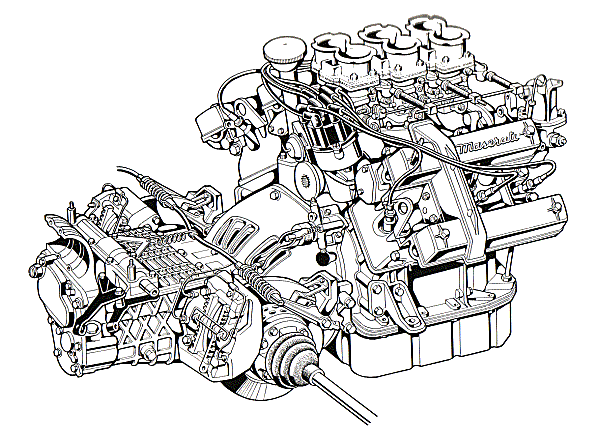 |
The refusal on the part of Citroën to make any further investment into the company made the financial situation at Maserati so serious that on the 23rd of May 1974, Citroën placed the company into liquidation. These events meant that the Quattroporte II was unable to complete its full homologation process and only the 13 examples on the production line were completed when production ended. |
|||
| TECHNICAL DATA - TIPO 123 | |
| Body type | 4-door 4/5-seater Luxury Saloon |
| Production years | From 1974 to 1975 |
| Engine | Front engined V6 cylinder @ 90° |
| Bore and stroke | 91.6 mm X 75 mm |
| Engine capacity | 2965 cc |
| Compression ratio | 8.8:1 |
| Maximum power | 210 bhp @ 6000 rpm |
| Distribution | Four overhead camshafts, two valves per cylinder |
| Induction system | No 3 twin-choke down-draught 44 DCNF Weber carburettors |
| Ignition | Single with distributor |
| Lubrification | Forced with pressure pump |
| Transmission | Front wheel drive |
| Clutch | Single dry plate with hydraulic control |
| Gearbox | Manual 5-speed and reverse |
| Chassis | Body integral with frame and support-chassis |
| Front suspension:- | Independent wheels with hydropneumatic suspension - automatic self-leveling system - Possibility to change road clearance when necessary |
| Rear suspension:- | Independent wheels with hydropneumatic suspension - automatic self-leveling system - Possibility to change road clearance when necessary |
| Brakes | 4 twin circuit disc brakes with automatic distribution of load |
| Wheelbase | 3070 mm |
| Wheel tracks | Front 1520 mm Rear 1490 mm |
| Tyres | Front:- 205x70 VR15 Rear:- 205x70 VR15 |
| Dry weight | 1600 kg |
| Overall length | 5130 mm |
| Overall width | 1870 mm |
| Overall height | 1370 mm |
| Maximum speed | over 200 kph (245 kph) |
| Models constructed | 13 |
Brochures courtesy of Dr. George Lipperts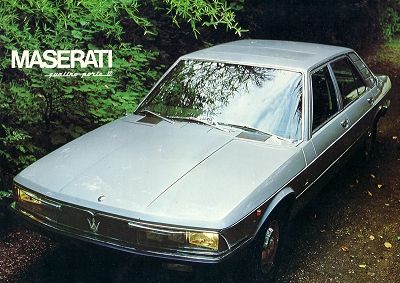 |
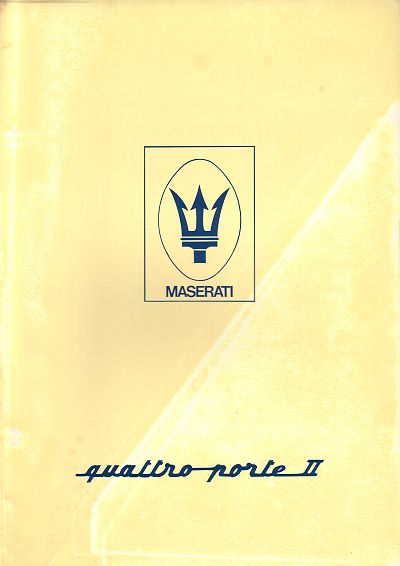 (contains many schematic drawings and full technical specification) |
|
To enter Enrico's Maserati Pages CLICK HERE! Copyright: Enrico's Maserati Pages - © 2003-2004. All rights reserved. |
